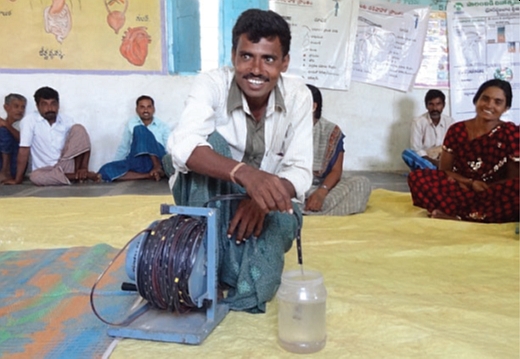
A farmer in India testing a groundwater dip meter (photo: Ruth Meinzen-Dick).
Drought management and groundwater management are almost synonymous in the South Asia region (Afghanistan, Bangladesh, Bhutan, India, Maldives, Nepal, Pakistan and Sri Lanka), where groundwater is intensely used for drought-proofing water supply and irrigated food production. Already subject to high levels of seasonal and inter-annual variability, South Asia is particularly vulnerable to climate change because of a high dependency on monsoonal rainfall and glacier-fed rivers, a high exposure to sea level rise and storm surges, and a low adaptive capacity. As the region goes through climate and socioeconomic change, the future resilience of its population and ecosystems will hinge, in part, on sustainable management of groundwater. Already, a sizable proportion of the population is affected by groundwater overexploitation and contamination, undermining community resilience to drought.
A series of reports, published recently by the World Bank, identifies, analyzes and recommends management interventions that aid reforms of groundwater governance and, thus, greater sustainability of groundwater and strengthened drought resilience in the South Asia region. A broad analytical framework and a series of case studies cover a range of policy and management approaches in different hydrogeological and socioeconomic settings with reference to key groundwater challenges. The reports were prepared by a World Bank team as part of a technical assistance project under the South Asia Water Initiative (SAWI) Regional Cross-Cutting Knowledge, Dialogue, and Cooperation Focus Area, with contributions from the International Water Management Institute (IWMI) and partners in the region.
Requirements for improvements to groundwater governance in South Asia are found to be complex, but some necessary priorities include the following:
- Strengthening policies that reduce inequity among groundwater users and other beneficiaries of the resource.
- Assessing gaps in supporting laws and regulations.
- Building institutional capacity within relevant branches of the government.
- Supporting the acquisition of regional and national datasets to fill major information gaps.
- Adopting a cross-sectoral approach to improving governance.
- Building regional cooperation wherever possible.
- Investing in new research to protect and safely develop groundwater resources.
- Limiting perverse incentives that indirectly cause excessive pumping of water.
- Communicating groundwater issues to audiences extending beyond traditional stakeholders.
Countries and communities across South Asia are implementing a range of innovative techniques and approaches appropriate to specific groundwater environments and scales, and aimed at better management of the resource without forsaking the beneficial services it provides. The techniques focus on participatory management, managed aquifer recharge, smart metering of tube wells, conjunctive management and interventions on the energy side to discourage over-pumping. Although these techniques show promise, their application to date generally remains limited. Importantly, they require participation from local communities and government institutions—and a variety of strategies for successful upscaling.
Main report
Supporting case studies
- Can Participatory Groundwater Management Enhance Drought Resilience? The Case of the Andhra Pradesh Farmer-Managed Groundwater Systems Project
- Drought-Proofing through Groundwater Recharge: Lessons from Chief Ministers’ Initiatives in Four Indian States
- Groundwater Management in Balochistan, Pakistan: A Case Study of Karez Rehabilitation
- Pro-Poor Groundwater Development: The Case of the Barind Experiment in Bangladesh
- Groundwater and Surface Water in the Mega-Irrigation Systems of Pakistan: The Case for Conjunctive Management
- Mitigating Floods for Managing Droughts through Aquifer Storage: An Examination of Two Complementary Approaches
- Groundwater Governance and Adoption of Solar-Powered Irrigation Pumps: Experiences from the Eastern Gangetic Plains

A young man harvesting rice in the Barind region (photo: Sanjiv de Silva).










































